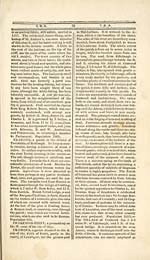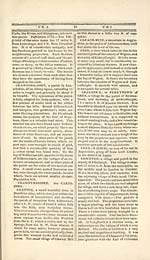Gazetteer of Scotland
(62) Page 60
Download files
Complete book:
Individual page:
Thumbnail gallery: Grid view | List view

cr a e
the ironworks carried on in the neighbour-
hood. The Amon is navigable for small
vessels nearly a quarter of a mile from the
Forth, forming a safe and commodious
harbour. To this harbour belong 8 or 10
sloops, employed by the Cramond Iron-
work Company.
CRANSHAWS, a small parish situated
in the midst of the Lammermuir hills, in
the county of Berwick. The surface con-
sists mostly of high hills covered -with heath,
and is therefore better adapted for pasture
than tillage. Every farm , however, possesses
a considerable portion of arable land, which
is generally cultivated and sown with tur-
nip, for the support of the sheep during the
severity of winter.- -Lime has been of the
greatest service in meliorating the soil.—
The rivers Whittadder and Dye water this
parish., The general appearance is naked
and bleak, having few trees of any kind.
Cranshaws castle is a strong ancient build-
ing, of small extent, but still very entire.
Population 1S6.
CRANSTON, a parish in the county of
Edinburgh, extending about rive miles in
length, and three in breadth. The surface
is unequal, but the gentle swellings of the
hills, adorned with fine seats and extensive
plantations, are extremely beautiful. The
soil is excellent, and the whole parish is a-
xable. The staple commodity is corn, of
"which a considerable quantity is exported.
Freestone, limestone, and pit-coal abound
here. There are three neat villages in it,
•viz. Cranston, Cousland, and Preston. Near
Cousland are some ruins, said to be of a
nunnery. The river Tyne, as yet a rivulet,
runs tlirough it. The elegant structures of
Oxenford castle and Preston hall, the pic-
turesque banks of the rivulet, and the lux-
uriant crops which adorn the fields, present
to the eye as rich a landscape as the most
fertile spot of England could furnish. Po-
pulation 960.
CRATHY and BRAEMARR. These
extensive united parishes are situated in
that district of Aberdeenshire called Marr,
in the middle of the Grampian mountains,
and are supposed to be more elevated above
the level of the sea, and farther removed in
every direction of the coast, than any other
parochial district in Scotland. Taking in
the mountainous and waste district, the
•whole will cover an extent of 40 miles in
length 'and 20 in breadth. In the low
grounds the soil is various, but when pro-
perly cultivated, and in a favourable sea-
son, it produces good crops. By far the
greater part is covered with high moun-
C R A
tains. Nearly the whole of Crathy and Brae-
marrhasbeen originally covered with wood,
and was called the forest of Marr. This fo -
rest, with those of the Duke of Athol in
Perthshire, and the Duke of Gordon in Ba-
denoch and Glenaven, constituted theprin-
cipal part of the great Caledonian forest. In
the deepest mosses there are found large
logs and roots of trees, which afford incon-
trovertible proof that they have formerly
been full of timber. In Braemarr, a great
part of the wood still remains. These woods
are well stocked with deer. Besides the
natural wood, there are extensive planta-
tations of fir and larch ; of the former of
which, one proprietor alone has planted up-
wards of 14 millions of trees. The river
Dee takes its rise in the forest of Eraemarr,
and runs through the whole extent of the
district. The principal lakes are Loch Cal.
lader and Loch Brotochan, which contain
trout, salmon, and eels. The great milita-
ry road from Blairgowrie to Fort George,
passes through the whole extent ; the vil.
lage of Castletown of Braemarr is situated
on that line of road. Near this village are
the ruins of an old castle, said to have been
the seat of King Malcolm Canmore. At a
short distance is the castle of Braemarr. It
was once occupied as a garrison by King
William, and wasburnt in thecontest which
took placebetwcen the royal forces and the
Earl of Marr. Near the line of the military
road is a large cairn, called Cairn-na-cuim-
hne, or " Cairn of Remembrance." The
mountains produce emeralds, topazes, ame-
thysts, similar to the precious stones of
Cairngorum. Granite of a fine polish also
abounds, and there are inexhaustible quar-
ries of limestone, and of fine slate. Popu-
lation 1965.
CRAWFORD, a parish in Lanarkshire,
in length about 18 miles, and 15 in breadth.
The hill of Lauders, of which the elevation
is 5150 feet, is chiefly in this parish. The
greater part of the district consists of hills
and moors, some of which are fit for pasture,
but many are bleak, and scarcely exhibit
marks of vegetation. In the vallies the soil
is generally light and spongy ; but in some
places there is clay. The situation and
climate, however, even of the best grounds,
are unfavourable for agriculture- Minera-
logists would find great field for research
in the grounds here, Leadhills, containing
the most extensive mines in the kingdom,
is in this parish. The Earl of Hopetoun
has in his possession a mass of lead ore
weighing 5 tons, and a piece of native gold
found here of 2 ounces. The Daer, the
the ironworks carried on in the neighbour-
hood. The Amon is navigable for small
vessels nearly a quarter of a mile from the
Forth, forming a safe and commodious
harbour. To this harbour belong 8 or 10
sloops, employed by the Cramond Iron-
work Company.
CRANSHAWS, a small parish situated
in the midst of the Lammermuir hills, in
the county of Berwick. The surface con-
sists mostly of high hills covered -with heath,
and is therefore better adapted for pasture
than tillage. Every farm , however, possesses
a considerable portion of arable land, which
is generally cultivated and sown with tur-
nip, for the support of the sheep during the
severity of winter.- -Lime has been of the
greatest service in meliorating the soil.—
The rivers Whittadder and Dye water this
parish., The general appearance is naked
and bleak, having few trees of any kind.
Cranshaws castle is a strong ancient build-
ing, of small extent, but still very entire.
Population 1S6.
CRANSTON, a parish in the county of
Edinburgh, extending about rive miles in
length, and three in breadth. The surface
is unequal, but the gentle swellings of the
hills, adorned with fine seats and extensive
plantations, are extremely beautiful. The
soil is excellent, and the whole parish is a-
xable. The staple commodity is corn, of
"which a considerable quantity is exported.
Freestone, limestone, and pit-coal abound
here. There are three neat villages in it,
•viz. Cranston, Cousland, and Preston. Near
Cousland are some ruins, said to be of a
nunnery. The river Tyne, as yet a rivulet,
runs tlirough it. The elegant structures of
Oxenford castle and Preston hall, the pic-
turesque banks of the rivulet, and the lux-
uriant crops which adorn the fields, present
to the eye as rich a landscape as the most
fertile spot of England could furnish. Po-
pulation 960.
CRATHY and BRAEMARR. These
extensive united parishes are situated in
that district of Aberdeenshire called Marr,
in the middle of the Grampian mountains,
and are supposed to be more elevated above
the level of the sea, and farther removed in
every direction of the coast, than any other
parochial district in Scotland. Taking in
the mountainous and waste district, the
•whole will cover an extent of 40 miles in
length 'and 20 in breadth. In the low
grounds the soil is various, but when pro-
perly cultivated, and in a favourable sea-
son, it produces good crops. By far the
greater part is covered with high moun-
C R A
tains. Nearly the whole of Crathy and Brae-
marrhasbeen originally covered with wood,
and was called the forest of Marr. This fo -
rest, with those of the Duke of Athol in
Perthshire, and the Duke of Gordon in Ba-
denoch and Glenaven, constituted theprin-
cipal part of the great Caledonian forest. In
the deepest mosses there are found large
logs and roots of trees, which afford incon-
trovertible proof that they have formerly
been full of timber. In Braemarr, a great
part of the wood still remains. These woods
are well stocked with deer. Besides the
natural wood, there are extensive planta-
tations of fir and larch ; of the former of
which, one proprietor alone has planted up-
wards of 14 millions of trees. The river
Dee takes its rise in the forest of Eraemarr,
and runs through the whole extent of the
district. The principal lakes are Loch Cal.
lader and Loch Brotochan, which contain
trout, salmon, and eels. The great milita-
ry road from Blairgowrie to Fort George,
passes through the whole extent ; the vil.
lage of Castletown of Braemarr is situated
on that line of road. Near this village are
the ruins of an old castle, said to have been
the seat of King Malcolm Canmore. At a
short distance is the castle of Braemarr. It
was once occupied as a garrison by King
William, and wasburnt in thecontest which
took placebetwcen the royal forces and the
Earl of Marr. Near the line of the military
road is a large cairn, called Cairn-na-cuim-
hne, or " Cairn of Remembrance." The
mountains produce emeralds, topazes, ame-
thysts, similar to the precious stones of
Cairngorum. Granite of a fine polish also
abounds, and there are inexhaustible quar-
ries of limestone, and of fine slate. Popu-
lation 1965.
CRAWFORD, a parish in Lanarkshire,
in length about 18 miles, and 15 in breadth.
The hill of Lauders, of which the elevation
is 5150 feet, is chiefly in this parish. The
greater part of the district consists of hills
and moors, some of which are fit for pasture,
but many are bleak, and scarcely exhibit
marks of vegetation. In the vallies the soil
is generally light and spongy ; but in some
places there is clay. The situation and
climate, however, even of the best grounds,
are unfavourable for agriculture- Minera-
logists would find great field for research
in the grounds here, Leadhills, containing
the most extensive mines in the kingdom,
is in this parish. The Earl of Hopetoun
has in his possession a mass of lead ore
weighing 5 tons, and a piece of native gold
found here of 2 ounces. The Daer, the
Set display mode to: Large image | Transcription
Images and transcriptions on this page, including medium image downloads, may be used under the Creative Commons Attribution 4.0 International Licence unless otherwise stated. ![]()
| Gazetteers of Scotland, 1803-1901 > Gazetteer of Scotland > (62) Page 60 |
|---|
| Permanent URL | https://digital.nls.uk/97422438 |
|---|

